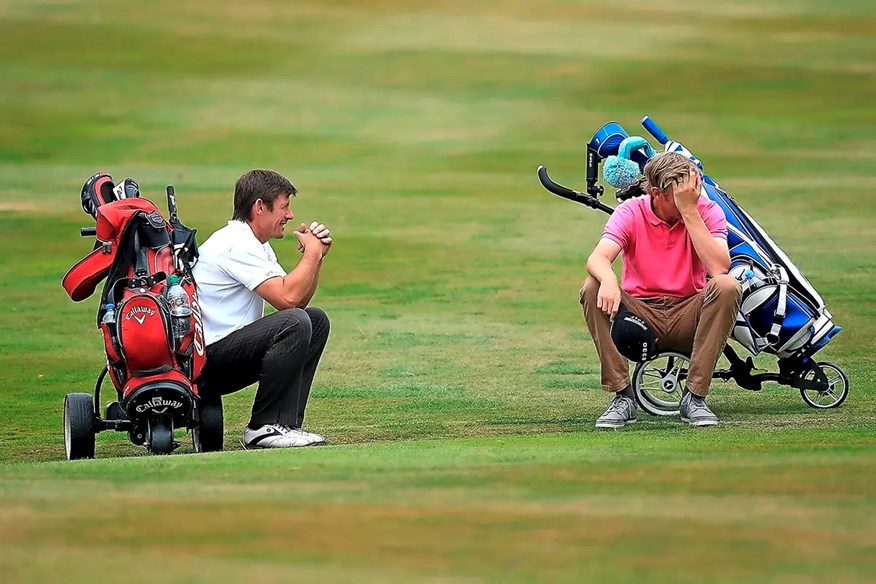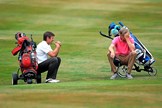One governing body has the answer to golf’s slow play crisis – and it could be coming to YOUR club
Last updated:

A new system has revolutionized golfers’ attitudes to pace of play and, in some cases, had them ‘running down fairways’. Alex Perry went to find out more
Some governing bodies are taking slow play in golf more seriously than others. The LPGA, for example, will soon start implementing a much stricter policy for the worst offenders. The PGA Tour, meanwhile, have opted to reduce fines and allow distance-measuring devices in some tournaments.
DP World Tour player Andrew Johnston, in his latest column for TG, said the current system allows slow players to be slow, which in turn has a knock-on effect which ultimately sees those caught behind them on the end of a penalty.
England Golf, though, believe they have devised a system that not only keeps rounds within an acceptable time, but has completely changed players’ attitude on an often-divisive topic.
It started a few years ago, when the Woodhall Spa-based governing body decided that, instead of having a small gap in the tee times every 10 groups or so, to just split the field in two and put a 50-minute gap between the last tee time of the first session and the first tee time of the second session.
The benefits of that small but significant change, England Golf’s director of championships James Crampton tells TG, is twofold.
“It allows us to reset the clock if that first session has some difficulty so it doesn’t affect the whole field,” he explains. “It also allows the second group of players to have, essentially, a free golf course to play into.
“What we’ve seen from that is that second session of players in the field are coming in significantly under the pace-of-play time that we allocate for the round. It’s been a huge positive.”
But Crampton was still concerned about what he describes as a “yeah, whatever attitude” from a number of players when told they were out of position.
So he and his team set about coming up with a new system which is now about to be rolled out for a second year.
England Golf’s system to tackle slow play
Debuted last year in all England Golf championships, the premise is simple. There is a pace-of-play station every four or five holes, and each hole is allocated an expected time in which every group must finish. Those times take into account the hole’s difficulty and length, as well as any extended walks between greens and tees.
Each station is manned by a volunteer and their job is to record the check-in time of each group, and that will then correspond to their allocated time to reach the next station. Referees, meanwhile, continue to monitor the pace of play out on the course.
So instead of players being individually timed over each shot, they are told, as a group, that they must reach each pace-of-play station within the allotted timeframe. Failure to do so will result in a warning.
“We don’t literally show a yellow card, like in football,” Crampton explains, “but it’s a similar principle.
“If a group misses that first checkpoint, we’ll have a referee there who will identify that they’ve missed their time, and advise them to make the next checkpoint in time.
“The referee then leaves them to it. We don’t monitor them by driving down the side of the fairway and timing players individually, because we find that that’s quite off-putting and unhelpful. But we keep an eye on them from afar and see how they progress.
“Inevitably, as a group, they will apply ‘ready golf’ and do everything that can to ensure they make that next checkpoint. And, of course, the one after that, too.
“If they fail to do so, then there is a danger that the three players within that group will be penalized a shot.”
There is wiggle room, of course.
Crampton continues: “We do have things within our policy that allow us to not apply a penalty, and if we think the group has made every effort or there’s a circumstance that would warrant us withdrawing that penalty.
“For example, if we’ve got a group who’s missed a pace-of-play checkpoint and they’ve got right back up to the group in front of them, and then on the very last hole before the next checkpoint there’s been an extended ruling, or one of the players has had a bit of a disaster, that would be an example where we would not apply a penalty. They’ve effectively made every effort, and it was just an unfortunate circumstance.
“We also have situations within the policy where, if a group is being monitored but it’s quite evident that one player is the sole culprit and therefore it wouldn’t be appropriate to penalize all three players, we can instead individually time the slow player and apply penalties to them if needed.
“But the policy covers various examples and circumstances that we might encounter on the course that allow us to not issue a penalty, because the policy is not there to apply penalties, and we make every effort we can to not apply one.
Searching for a wayward ball, though? That is not one of those circumstances.
“That’s the sort of thing you encounter during a round of golf that you have to manage, and it’s your responsibility to make sure you catch that time up,” Crampton explains.
“But you might have a situation where a ruling is needed and the player has to wait five or six minutes for a referee which has caused them to miss their checkpoint. That would be an example where we would remove that penalty from that group.
“That said, we are certainly not frightened to apply one if the case is needed and players are not abiding by the policies.”
For Crampton, the most pleasing aspect of the new policy isn’t just the fact that rounds are now regularly timed in on the right side of four and a half hours – “Which, when we’re talking about 144 competitors on some of the best and hardest golf courses in the country, is a pretty good time” – but how the players have responded.
“Previously, they knew they had an obligation to get around the golf course, but didn’t really put a lot of thought into it,” Crampton explains.
“Now there’s a real threat of penalty shots if they fail to meet these checkpoint stations, players have changed their attitude and become more aware of their roles and responsibilities around pace of play, and that has made them more aware of how fast they walk, how long they spend looking at their yardage books, using their lasers, reading putts, taking their glove off and putting it back on.
“All that is now at the forefront of their mind and so, collectively, they’re moving around quicker because they are doing all their processes and procedures in a better way than they may have done in the past.
“Our policy doesn’t take into account how long it takes you to hit your ball. If you want to run down the fairway and then take two minutes to play your shot, that’s absolutely fine, just as long as you’re with a group in front and you meet your checkpoint stations.”
It begs the question: has that happened?
“Of course,” Crampton smiles. “We’ve had a couple of instances where players were practically sprinting.
“I have no problem with that. They were warned and they took no notice, and then I turn up on the tee and say, ‘Guys, you are really in danger of missing this next checkpoint.’ And they’ll ask, ‘Well, what do we need to do?’ And I’ll tell them they need to run. And the three of them did just that, they all made pars, and they made their checkpoint station by 15 seconds – otherwise they would have been penalized.
“So it does have an effect, not necessarily in significant changes in the round times, but certainly in terms of players awareness and attitude towards pace of play.”
Surely, then, this is something that can be rolled out by more governing bodies, and even at tour level?
“There’s no reason why it can’t be implemented elsewhere,” Crampton says. “I understand that the tour guys play for a lot of money, but financial penalties don’t seem to be the solution. It’s shot penalties that are going to solve the problem, and this is something slightly different to try and sort out a problem that’s been going on for a significant period of time.”
More pressing for Crampton, though, is his desire to roll the policy out at club level.
“We’re going to look at how we can use it in handicap competitions,” Crampton confirms, “and how we can provide guidance to golf clubs in terms of how they could potentially use a hybrid system at their own clubs.
“The main issue is you can’t simply say to a group, ‘You need to be here at a certain time.’ You need personnel on the golf course to monitor timings. But it’s something we’re looking at closely.”
